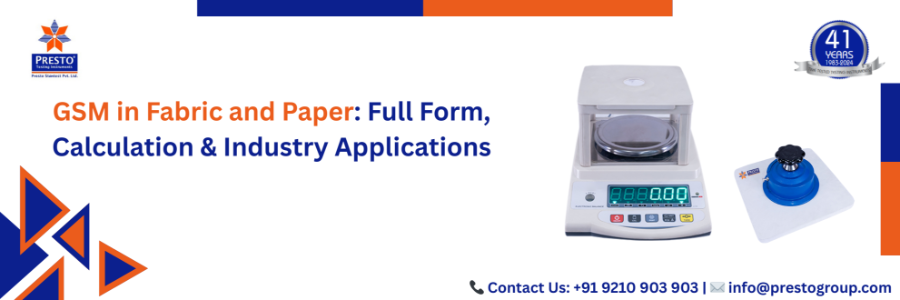

Ever get your hands on a piece of paper or cloth and wonder what makes it feel so good? Perhaps it’s the weight, the thickness, or the way it flows. That’s where GSM comes in—a word that’s like a secret code for anyone who deals with paper, fabric, or textiles. GSM, which stands for Gram per Square Meter, is a measure of how heavy a material is and is widely used in printing, fashion, and packaging, among other materials. In this blog, we are going to break down everything about GSM: what it means, how to calculate it, and how important it is for things like your favorite t-shirt or even that fancy business card. Let’s brew ourselves a cup and see what we’re curious about!
The full form of GSM is “Gram per Square Meter”. It measures the weight of a material—whether paper, fabric, cloth, or any textile—by calculating how many grams a single square meter of it weighs. The higher the GSM, the heavier and usually thicker the material.

GSM is like a universal yardstick that helps everyone—designers, manufacturers, even shoppers—pick the right material for the job. But how do you actually figure out what a material’s GSM is? That’s where some simple math comes in.
Don’t worry if numbers aren’t your best friend—calculating GSM is pretty easy once you get the hang of it. The Gram per Square Meter formula is:
GSM = Weight (in grams) ÷ Area (in square meters)
Here’s how to do it step by step:
Let’s say you’ve got a piece of cloth that weighs 75 grams and measures 1 meter by 1 meter (so, 1 square meter). Plug it into the formula:
GSM = 75 grams ÷ 1 square meter = 75 GSM
This cloth is super lightweight, maybe perfect for a sheer blouse or a delicate curtain.

If you’d rather skip the math, a GSM calculator is your new best friend. These are usually online tools or apps where you punch in the weight and dimensions, and they spit out the GSM in seconds. Some factories even have fancy machines that measure GSM automatically for big rolls of material. Whether you’re crunching numbers by hand or using a calculator, knowing the GSM gives you a clear picture of what you’re working with.
GSM isn’t just a random number—it’s a game-changer for deciding how a material will behave in the real world. Let’s see how it’s used in two major industries: paper and textiles.
When it comes to paper, GSM is like the DNA of the sheet. It tells you how thick, strong, or flexible it is, which decides what it’s good for. Here’s the breakdown:
Picking the right GSM means your paper won’t tear in a printer or feel flimsy in a client’s hands.
In the world of fabric and cloth, GSM is just as crucial. It helps you choose the perfect material for everything from clothes to couch covers. Here’s how it works:-
GSM also affects how a fabric feels and moves. A low-GSM silk might float like a dream but tear easily, while a high-GSM cotton is built to take a beating but might feel stiff.
Here’s a table to sum up common GSM ranges and their applications:
| Material | GSM Range | Common Uses |
| Paper | 70-100 GSM | Printer paper, notebooks, handouts |
| Paper | 120-150 GSM | Flyers, brochures, posters |
| Paper | 200+ GSM | Business cards, packaging, art paper |
| Fabric | 100-150 GSM | T-shirts, summer dresses, scarves |
| Fabric | 150-250 GSM | Shirts, pants, light jackets |
| Fabric | 250+ GSM | Denim, canvas, upholstery |
This table gives you a snapshot of how GSM translates to real-world uses, whether you’re printing a flyer or sewing a jacket.
GSM isn’t limited to paper and textiles. It’s also used for:
GSM is like a Swiss Army knife for material selection across industries.
GSM Pops Up in Other Places Too:
In short, GSM is a reliable guide for anyone working with materials that need to perform in a specific way.
A material’s GSM isn’t set in stone—it depends on a few factors:
Knowing these factors helps manufacturers keep GSM consistent and hit the sweet spot for their products.
Whether you’re designing a dress, printing a poster, or DIY-ing a project, here are some tips for picking the perfect GSM:
Got questions? Here are answers to four common ones about GSM:
1. What’s the difference between GSM for paper and fabric?
GSM measures weight per square meter for both, but the context differs. In paper, it’s about thickness and printability. In fabric, it’s about weight, drape, and durability for things like clothes or curtains.
2. How do I choose the appropriate GSM for my project?
what you're creating. When it comes to paper, 80 GSM is adequate for printing but 200+ GSM is best for cards or packaging. For textile 100-150 GSM is good for light clothes and 300+ GSM for heavy items such as coat.
3. Can I calculate GSM myself?
Absolutely! Weigh your material in grams, measure its area in square meters, and divide weight by area. Or, use a GSM calculator online for a quick answer.
4. Does higher GSM mean better quality?
Not always. Higher GSM means heavier material, but “better” depends on your needs. A 500 GSM paper is overkill for a flyer, just like a 100 GSM fabric won’t hold up for a backpack.
What Does GSM Mean? This Small Number Has More Meaning Than You Could Imagine.
Curious how to pick the right paper weight for your wedding invitation or the best fabric for your new jacket? Knowing GSM – or Gram per Square Meter – and applying the same formula or even better: Outshine your friends and their baffled looks when they ask your opinion on how there’s just more to this magical number. It's like having superpowers to choose materials based on exactly how you want them to look, feel, and perform.
So next time you’re holding a piece of paper or a roll of fabric, look for the GSM: that’s how you make sure you’re getting exactly what you want.
Looking for accurate and affordable testing solutions? Contact us now to learn more about our Gram per Square Meter testers and get the best price tailored to your needs.
Call us: +91 9210 903 903
Email: info@prestogroup.com
Connect with us for your business enquiries. Generally, we respond within one or two working days.